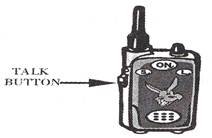-
Persuasion is the art of talking someone into agreeing with you. 1.
Ethos(理念) is a speaker’s way of persuading the audience that he is a dependable person.
2. For example, a speaker can develop ethos by explaining how much experience or education he has in a certain field. After all, you would be more willing to follow advice about how to educate your child from a teacher than a doctor.
Pathos(感染力) is a speaker’s way of connecting with an audience’s emotions. For example, a speaker who want people to vote for him might say that he can make the country richer and stronger.3.
Logos(理性) is the use of facts, statistics, or other evidence to make the argument more persuasive. 4. For example, an ad for soap might say that laboratory tests have shown that their soap kills all 7,000,000 of the bacteria on your hand, which might make it more probable for you to buy their soap. Presenting this evidence is much more persuasive than simply saying “our soap is the best”.
Although the three tools above all have their strengths, they work best when used together.
5. Next time you listen to a speech, watch a commercial or listen to a friend trying to persuade you to lend him money, just remember these ancient Greek tools of persuasion.
A. These words can bring people great hope, making them want to vote for him.
B. These pictures are intended to fill the viewers with pity.
C. An audience will more probably believe you if you have data to support your opinions.
D. Use of logos can also increase a speaker’s ethos.
E. According to Aristotle, there are three basic tools of persuasion: ethos, pathos and logos.
F. In fact, most speakers use a mix of ethos, pathos and logos to persuade their audience.
G. An audience will consider a speaker dependable if he seems trustworthy, reliable and sincere.
高一英语七选五中等难度题查看答案及解析
-
Small talk is a popular way of getting to know someone, getting into a school or job, or just passing the time. But do you think you're good at it? And do you even know how to do it? If not, then it’s never too late to learn. The art of small talk is the art of talking about unimportant things like the weather. So why should you find it important?
It's completely free. It doesn't matter if you fail, and you never know where it will go. “It can lead to many results,from a pleasant exchange to the signing of a million dollar business deal”,according to Brett Nelson in Forbes Magazine. The good things to small talk don't stop there. It can also make us smarter, as a study by researchers at the University of Michigan found that friendly, social communication could help us solve problems.
You may be wondering how best to break this ice. Weather is probably the number one thing that people who do not know each other will discuss. Sports news in also a very common topic, especially if a local team or player is doing extremely well or badly. And if you and the other speaker have something in common, that may also he acceptable to talk about. For example, if the bus you are on is full, you might talk about the reasons why.
Complimenting (恭维)someone on their clothing or hair is acceptable; however, you should probably not say anything — good or bad一about a person's body. Basically, any subject that makes the other person give a deep-thought answer in not welcome. If you bring up something like death, religion, politics, for serious opinions, you will turn people off.
1.The 2nd paragraph is mainly about .
A. the topics of small talk B. the development of small talk
C. the art of small talk D. the advantage of small talk
2.Which is the first choice for strangers to break the ice?
A. Weather. B. Clothing.
C. Sport D. Music
3.The underlined sentence in the last paragraph means people will .
A. feel interested in your talk B. quarrel with you for your talk
C. get tired of your talk D. be grateful for your talk
4.Which part of a magazine might this text belong to?
A. Science & Technology B. Social Communications.
C. Modern Fashion. D. Travel Around the World.
高一英语阅读理解简单题查看答案及解析
-
Teenagers may run into many problems and it is a _____ for them to be able to talk to someone who understands their problems.
A. relief B. pity
C. surprise D. shame
高一英语单项填空简单题查看答案及解析
-
The Hong Kong Arts Festival is made possible with the funding support of:
The Hong Kong Jockey Club Charities Trust
Leisure and Cultural Services Department
The Organizers reserve the right to substitute artists and change programme details should unavoidable circumstances render it necessary

BUY NOW at ticket office
Online Bookings: WWW. urbtix.hk
Credit Card Telephone Bookings: 2111 5999
WWW.hk.artsfestival.org
1.How many days will the two jazz masters perform in Hong Kong?
A. 2 days. B. 3 days. C. 4 days. D. 5 days.
2.You can get a ticket except that ______.
A. you go and buy one at the ticket office B. you book online
C. you call and pay with your credit card D. you wait to get one for free
3.Why will the two jazz masters perform in Hong Kong?
A. Because they meet in there after not seeing each other for 40 years.
B. It’s for Hong Kong Arts Festival.
C. Because they can’t live without music.
D. It just happens that they two are performing there.
高一英语阅读理解中等难度题查看答案及解析
-
The Hong Kong Arts Festival is made possible with the funding support of:
The Hong Kong Jockey Club Charities Trust
Leisure and Cultural Services Department
The Organizers reserve the right to substitute artists and change programme details should unavoidable circumstances render it necessary

BUY NOW at ticket office
Online Bookings: WWW. urbtix.hk
Credit Card Telephone Bookings: 2111 5999
WWW.hk.artsfestival.org
1.How many days will the two jazz masters perform in Hong Kong?
A. 2 days. B. 3 days. C. 4 days. D. 5 days.
2.You can get a ticket except that ______.
A. you go and buy one at the ticket office B. you book online
C. you call and pay with your credit card D. you wait to get one for free
3.Why will the two jazz masters perform in Hong Kong?
A. Because they meet in there after not seeing each other for 40 years.
B. It’s for Hong Kong Arts Festival.
C. Because they can’t live without music.
D. It just happens that they two are performing there.
高一英语阅读理解中等难度题查看答案及解析
-
Ideally speaking, criticism(批评) is the act of making comments on someone or something with the purpose of improving products or service. However in daily life, you will meet some people criticizing with the negative purposes,
What should you do when you are being criticized? Actually, you should take it positively. It is possible that the person who criticizes you has rightly drawn your attention to something which needs improving. If this is the case, be thankful to the person because he is helping you to know where to improve.
However, there is also a chance that the criticism is being done just to make you sad. So if necessary, ask one of your friends or workmates what he thinks of this criticism. If the criticism is really meant to hurt you, pay no attention to it and don’t allow it to disturb your peace of mind.
When you are criticizing someone or something, always remember that negative criticism causes negative energy, so try to criticize in a positive manner. Do not become the “full stop” for someone’s creativity
Whenever you are about to criticize, ask yourself whether your purpose is to help the person or if you are just going to spread negativity which will damage someone’s creative skills.
If you really want to criticize someone, do it in an encouraging way. Try to give your comments in this way so that he can put your suggestions into corrective(改正的) actions. What’s more, you should remember the fact that complaining is taking criticism to the next level which is even more damaging and dangerous. So try to remain inside the limits of criticism instead of complaining.
Title: On criticism
I. 1. _____________
Generally, criticism means 2. ________ on somebody or something to improve products or service. However, not all people criticize with positive purposes.
II. How to 3. _________criticism against you
● Thank someone who criticizes you positively because he helps you know 4._________
● Ask for 5.________ from friends or workmates to know the purpose of criticism
●6.________ negative criticism and protect your peace of mind
III. What to do when you want to criticize
● Try to criticize positively in order not to damage 7._________
● Ensure that your criticism is 8. __________ to the person
● Criticize someone in an encouraging way to get him to act 9._________accordint to your suggestions
● Just criticize and don’t 10. __________
高一英语其他题中等难度题查看答案及解析
-
With beautiful canals, top art museums, and cycling culture I Amsterdam is one of the most popular travel destinations in the world. As the capital and most populous city in the Netherlands, it’s often referred to as the “Venice of the North” because of its wide system of bridges and canals. Here are some key points for you to keep in mind while planning a trip there.

Must-See Attractions
Most visitors begin their Amsterdam adventure in the Old Centre, which is full of traditional architecture, shopping centers, and coffee shops. The top museums to visit are the Rijks museum, the Ann Frank House, and the Van Gogh Museum. As a World Heritage Site, the Canal Ring was originally built to attract wealthy home owners and an area for celebrity spotting and nightlife today.
Transportation
Travelers should be aware that Amsterdam Airport Schiphol is one of the busiest airports in the world. This airport is located about 15 kilometers southwest of the city center. You can catch a train from Schiphol to Amsterdam Central Station, which has many connecting routes. It’s not a good idea to drive a car to the city center. Cycling is popular here, and it’s easy to rent a cheap bike around the town. Amsterdam has a flat terrain (地形) and it’s a good choice to explore the city on foot.
Money-saving Tips
• Look for accommodations in Amsterdam’s South District where rates are generally cheaper than in the city center.
• Buy train tickets at the machine instead of the counter to save a bit of money.
• Instead of hiring a tour guide, jump onto a canal boat. They’re inexpensive and will give you a unique point of view of the city.
1.Why was the Canal Ring originally built in Amsterdam?
A. To build more museums.
B. To encourage rich people to live there.
C. To become a World Heritage Site.
D. To help people enjoy colorful nightlife.
2.What does the author advise for tourists to visit city center in Amsterdam?
A. Hiring a local tour guide.
B. Traveling to the city center by taxi.
C. Visiting the city by bike or on foot.
D. Avoiding the use of trains.
3.How can a tourist save money according to the author’s advice?
A. By hiring a professional guide.
B. By booking a hotel in the city center.
C. By buying all the tickets from the counter.
D. By visiting the city on a canal boat.
高一英语阅读理解简单题查看答案及解析
-
_______2010 in China, the number of students ________ to study art is rising a lot.
A.Compared with; choosing B.Comparing to; to choose
C.Composing with; chosen D.Compared to; choose
高一英语单项填空中等难度题查看答案及解析
-

You and your friends will have lots of fun with Rabbit
Ears Walkie -Talkies. You can talk to someone who is in another
room at your house or someone who is up to 180
feet away from you. You can take your walkie
-talkie with you when you go camping or walking.
Rabbit Ears Walkie -Talkies are easy to use. This is what you do:
1. Push the ON button.
2. Hold the TALK button in and say something. If your friend has his/her walkie - talkie on, he/she will hear you.
If you want to talk for a long time, you can lock the TALK button. Just push the button in and up. When you finish talking, push the TALK button down.
3. When you finish talking, let go of the TALK button and listen. When your friend pushes the TALK button and says something, you will hear what your friend says through your walkie -talkie.
4. When you finish talking with your friend, push the ON button again to turn your walkie-talkie off.
REMEMBER
◆If you cannot hear , push L (loud) to make it louder.
◆If it is too loud, push S (soft) to make it quieter.
1. What are Rabbit Ears Walkie -Talkies used for?
A.Locating places. B.Listening to music.
C.Giving directions. D.Talking with others.
2. How can you lock the TALK button?
A.Keep the button on. B.Hold the button back.
C.Push the button in and up. D.Turn the button off and down.
3. Which button will you push when you can't hear clearly?
A.L B.S C.TALK D.ON
4.The author writes this passage to _____.
A.show how to use Rabbit Ears Walkie -Talkies
B.explain to the readers his camping experience
C.introduce some special ways to make friends.
D.tell how to make Rabbit Ears Walkie –Talkies
高一英语阅读理解中等难度题查看答案及解析
-
l like to feel close to someone. It is nice to have a friend to talk, laugh and do things with. Surely, there are times when we need to be alone. We don't always want people around. But we would feel lonely if we never had a friend.
No two people are the same. Sometimes friends don't get along well, which doesn't mean that they no longer like each other. Most of the time they will go on being friends. Sometimes friends move away, then we feel very sad. We miss them much, but we can call them and write to them. Maybe we would never see them again, and we can make new friends. It is surprising to find out how much we like new people when we get to know them. Families sometimes name their children after a close friend. Many places are named after men and women, if they are friendly to people in a town. So are some schools. We think of these people when we go to these places.
There's more good news for people, if they have friends. These people live longer than those people if those don't have friends. Why? It could be that they are happier. Being happy helps you stay well. Or it could be just knowing that someone cares, if someone cares about you, you take better care of yourself.
1.The first paragraph tells us __________.
A.none needs friends
B.we always need friends around us
C.making friends is the need in people's life
D.we need to be alone
2.Which of the following is NOT mentioned in the passage?
A.People are happy when their friends leave them.
B.People may never see their friends after their friends move away.
C.People can know their friends in different ways.
D.People like their friends very much if they get to know them.
3.Which of the following is the most probable place people name after friendly people?
A.A house.
B.A room.
C.A library.
D.A village.
4.If people have friends, they would live longer, because __________.
A.they feel happier and healthier
B.they get a lot of help from their friends
C.they take better care of themselves
D.both A and C
5.This passage tells us __________.
A.that people are all friends
B.that people need friends
C.how to get to know friends
D.how to name a place
高一英语阅读理解中等难度题查看答案及解析